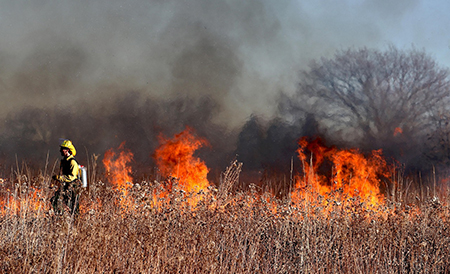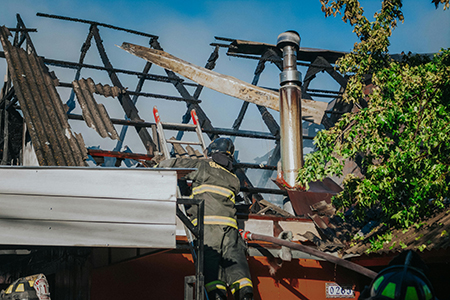California Wildfire Cause: Many people have been asking what caused the recent California wildfires. Wildfires have long been a recurring threat in California, but the 2025 fire season has proven to be one of the most devastating in recent history. The Palisades Fire and Eaton Fire, both igniting in early January, burned tens of thousands of acres, destroyed thousands of homes, and tragically claimed dozens of lives. These fires serve as a harsh reminder of the factors that contribute to such disasters and the challenges communities face in the aftermath. However, authorities have yet to find out the specific cause of the recent wildfires.
Common Causes of California Wildfires

California’s unique climate and geography, combined with human activity and aging infrastructure, make the state highly susceptible to wildfires. The 2025 wildfires were fueled by a combination of various factors.
Extreme Weather Conditions
Unusually strong Santa Ana winds, combined with high temperatures and low humidity, helped both the Palisades and Eaton fires spread uncontrollably.
Drought and Dry Vegetation
California entered 2025 with severe drought conditions, leaving forests and brushland exceptionally dry, creating the perfect fuel for fast-moving wildfires.
Human Activity
While the exact causes of the 2025 fires are still under investigation, preliminary reports suggest a combination of downed power lines, unattended campfires, and vehicle sparks as potential ignition sources.
Power Line Failures
Similar to previous disasters, power infrastructure has once again been linked to the ignition of wildfires. Investigations are underway to determine whether utility companies bear responsibility.
Lightning Strikes
Though less common, dry thunderstorms have been known to trigger multiple fires at once, overwhelming firefighting efforts.
Dealing with the Aftermath

The scale of destruction from the Palisades and Eaton fires has left thousands displaced, with at least 29 people dead, raising urgent concerns about recovery efforts. Dealing with the aftermath of a wildfire requires swift action at both individual and community levels:
Ensuring Safety and Following Evacuation Orders
Many residents affected by the 2025 wildfires faced sudden evacuation orders, underscoring the importance of staying alert and having a wildfire preparedness plan.
Assessing Property Damage
Homeowners and business owners impacted by the fires should document damage for insurance claims and disaster relief programs. California officials have already announced emergency funds to assist victims.
Restoring Utilities and Infrastructure
In fire-ravaged areas, restoring power, water, and road access remains a priority. Utility companies are working to repair damaged power grids while ensuring safer infrastructure moving forward.
Environmental Recovery Efforts
The aftermath of wildfires brings new dangers, including mudslides, soil erosion, and poor air quality. The state is working with environmental agencies to implement erosion control measures and reforest affected areas.
Looking Ahead
With wildfires becoming more frequent and severe, California faces ongoing challenges in fire prevention and recovery. The 2025 fire season serves as a wake-up call for stronger infrastructure, better emergency response systems, and proactive wildfire management strategies. As the state rebuilds, lessons learned from these disasters will key in shaping future policies.
How to Deal with the Aftermath of a Wildfire
Recovering from a wildfire requires careful planning and strategic action. Here are essential steps to take after the flames have subsided:
- Ensure Safety First
Before returning home, wait for clearance from local authorities. Wildfire hotspots may still exist, and the air quality could be hazardous. The Centers for Disease Control recommends protecting yourself from the ash by covering up. They also recommend wearing respirators.
- Assess Property Damage
Document the destruction by taking photos and videos for insurance claims. Make a detailed list of damaged property and contact your insurance provider promptly.
- Salvage Important Documents
One of the most overlooked yet critical aspects of disaster preparedness is securing important documents and valuables before a wildfire occurs. Having a fire-resistant bag can be a lifesaver in protecting important items. Important items that you should consider putting in fireproof bags include the following:
- Passports, birth certificates, and other identification documents
- Property deeds and insurance policies
- Cash, jewelry, and essential digital storage devices
- Family heirlooms and irreplaceable photographs, documents
A fire-resistant bag is designed to withstand extreme temperatures, preventing heat and flames from damaging critical items. Every household should have at least one to ensure essential documents are safeguarded in emergencies.
- Contact Relief Organizations
Organizations such as the Red Cross, FEMA, and local shelters provide emergency aid, temporary housing, and financial assistance to wildfire victims. These organizations can help by providing food, medical supplies, and essential hygiene kits to displaced families. Many relief groups also offer emotional support services and counseling to help survivors navigate the stress of losing homes and possessions. Reaching out to these agencies gives victims access to critical resources to stabilize their lives and begin the recovery process.
- Restore and Rebuild
Once your insurance claim is processed, begin rebuilding efforts. Consider investing in fire-resistant building materials and defensible landscaping (such as clearing dry vegetation around your property) to minimize future fire risks. Homeowners may also explore energy-efficient rebuilding options, including solar power and fire-resistant roofing, which can enhance sustainability while improving fire safety.
- Address Emotional and Mental Well-Being
Experiencing a wildfire can be traumatic. Seeking counseling, joining support groups, and maintaining open communication with loved ones can help cope with the stress and loss. Survivors often experience anxiety, grief, or post-traumatic stress disorder (PTSD), making mental health care a crucial part of recovery. Communities affected by wildfires can benefit from outreach programs and workshops designed to provide coping strategies and support. Engaging in these resources can help rebuild emotional resilience and restore a sense of normalcy after a disaster.
Final Thoughts
While wildfires are unpredictable, taking proactive measures can help mitigate their devastating impact. Understanding the causes, knowing how to recover effectively, and investing in fire-resistant solutions like a fireproof bag can make all the difference in securing what matters most. Preparation today ensures a safer and more resilient future for you and your family.
